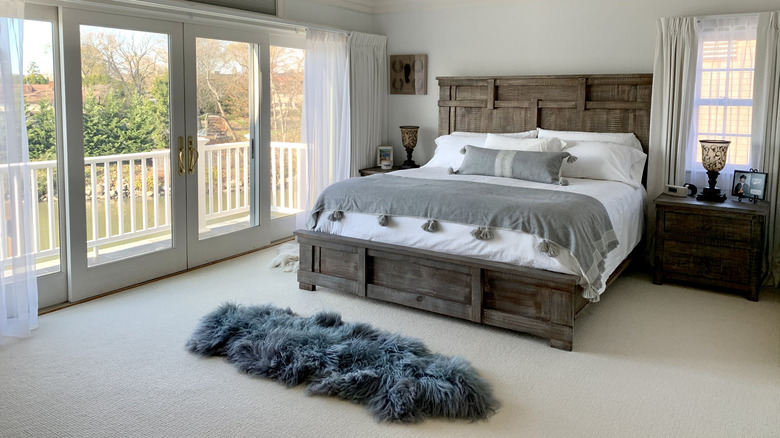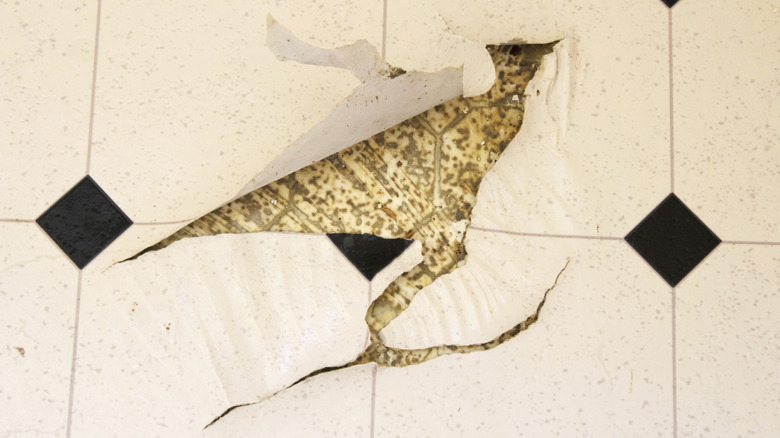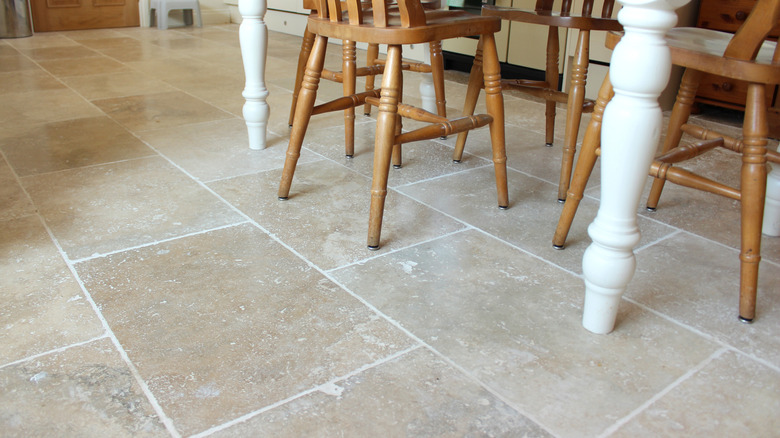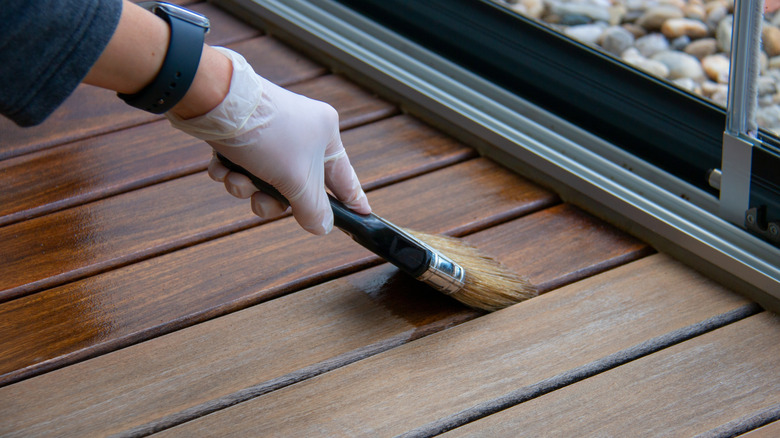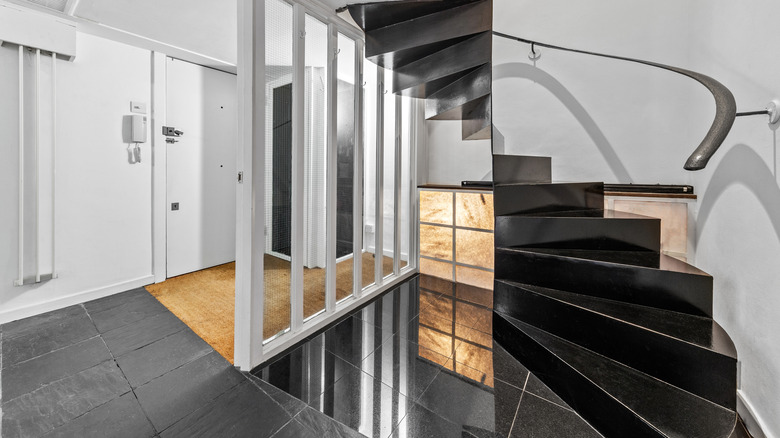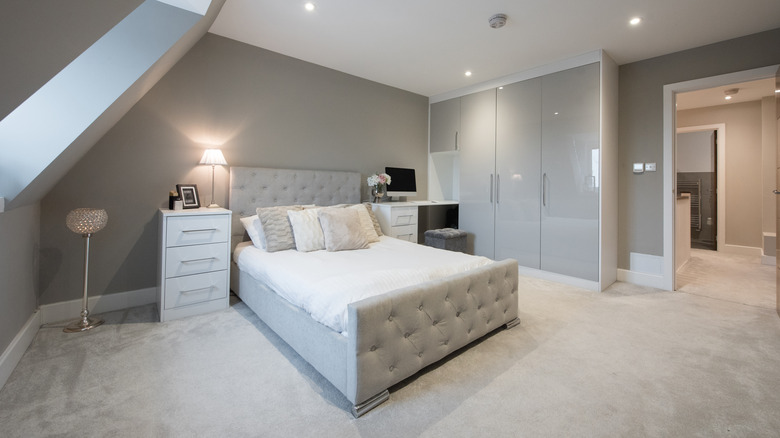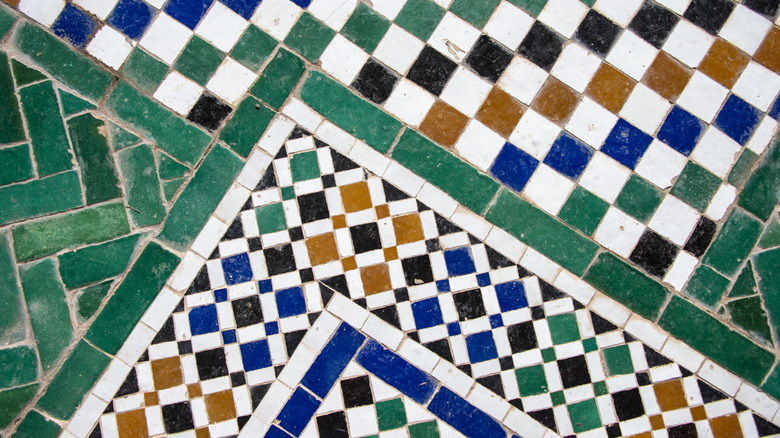Flooring Options HGTV Stars Are Tired Of Seeing In Homes
Installing new flooring in your home can be expensive, so you want to make sure to get it right the first time. As an avid HGTV fan, one of your first points of research is probably to know what your favorite stars recommend. But, perhaps even more importantly, it's worth knowing the types of flooring they don't like working with and why. After all, when you pool their portfolios, the top HGTV personalities have successfully renovated thousands of homes. They know what flooring works long-term for everyone and which options only seem to succeed if you have a certain lifestyle.
For instance, some don't like carpets because they think it's not durable. Others love carpet, but still advise being careful about the texture you choose, as it can easily create more cleaning demands than you're ready for. Whether you are planning on renovating soon or just want to know more about how these designers prefer to work, these are the flooring options HGTV stars are tired of seeing in homes.
Dave Marrs is over seeing vinyl and carpet
Redoing your home's floors can be both expensive and time-consuming. So if you are doing this renovation, it's likely you only want to do it once. With this in mind, Dave Marrs understands that most homeowners are looking for both style and longevity. You get the best value for money if you install something that lasts. "Some homeowners worry about the cost and maintenance of hardwood, but in the long run, it's one of the most cost-effective options because it lasts so much longer than carpets or vinyl," he told FLOOR Trends & Installation.
Carpets can stain and wear down, and vinyl is soft and can dent easily. However, Marrs insists that a classic hardwood might be a little more expensive during the renovation but will save you money over the years while still looking great. Yet, it is also true that hardwood might feel cold underfoot to some, or not be soft enough for pets or kids playing on the ground. Because of this, Marrs has a line of indoor rugs with his wife, Jenny, that pair perfectly with hardwood. "When creating the indoor line, we need something that tied a room together with a handwoven feel," the couple posted on Facebook. "These rugs allow you to get a beautiful texture that is comfortable and welcoming." You can grab a rug from this collection at Walmart, or get something comparable outside of their collection like the CHAMPLANT Area Rug, which is also washable.
Christina Haack is ready to leave travertine behind
Travertine is a type of limestone that was once very popular as a flooring option. However, Christina Haack is over it. "Like 15 years ago, everything was really heavy like travertine. It was kind of like travertine on brown and everything felt very dark," she told Parade. However, in addition to being out of style, travertine is a tough flooring option to swap out, so if it's in your house and you're trying to sell, you might run into issues. "I think when buyers look at that style, it's harder to fix because travertine's a hard material to get rid of," she continued.
If you don't already have travertine flooring, Haack is quick to advise you to stay away. Instead, she encouraged homeowners to stick with more classic options to avoid scaring off future buyers — or yourself in 10 years when you no longer love your dated flooring. "I would say sticking with a classic flooring, a classic color [is best]," she said. "Like the camelback, that's always a safe option because I don't feel that one will ever go out of style. It's not too light. It's not too dark. So I would just say more timeless." The camelback PVC is a type of vinyl flooring from Haack's collection that mimics the light, airy quality of natural hardwood. It's a sandy tan, a color that Haack thinks will maintain its popularity over the years without falling victim to changing trends.
Chip Gaines doesn't like overly stained hardwood floors
Classic hardwood is classic for a reason, but according to Chip Gaines, there is still a surefire way to ruin it: too much staining. "Flooring runs in the family, my dad and mom own a flooring company. For me, there's something about hardwood floor that does something to my soul, in a positive way," Chip said during "Breaking New Ground: Expanding the Silos," as reported by Apartment Therapy. "I see those natural hardwood floors and my heart jumps out of my chest. Don't put too much makeup on those babies, let's just let 'em fly."
To keep the hardwood you already own looking great sans stains, first consider buffing out the scratches and marks with a floor buffer. This will remove any imperfections, negating the need for added color to hide blemishes. If you don't own one, you can typically rent tools from hardware stores like Lowe's. Once the floor is buffed, simply add a clear coat finish on top of the wood to allow its natural color to shine. The clear finish is necessary since it will protect the raw wood underneath from scratches, water stains, and general wear and tear. However, there are both water- and oil-based polyurethane finishes, which come with their own sets of pros and cons. Water-based finishes will barely yellow with age, while oil-based finishes can begin turning yellow prior to five years. However, oil-based finishes are much cheaper than their water counterparts, often costing half the price. Water-based finishes also have lower VOC levels in them, making the off-gassing process shorter and the product safer to handle.
The Property Brothers are begging you to keep things cohesive with flooring types
When you have an open floor plan, the Property Brothers cannot be more clear about one thing: Do not mix flooring types! It's one of the biggest flooring mistakes to avoid at all costs. Jonathan Scott, in particular, is tired of seeing houses with a jigsaw puzzle of different flooring mixed together. While you might feel compelled to do this because the kitchen, bedroom, and living room have different flooring needs, it's always better to choose the material that works best for most of the space instead of chopping things up. "I have a rule: You should never see more than two types of flooring from any one place in your home," Scott said in Season 6, Episode 13 of "Property Brothers: Forever Home," per Realtor.com.
This problem shows up the most when transitioning from living spaces to kitchens. Since the latter is a wet space, people often worry about hardwood sustaining moisture damage. So, they pick tile instead. However, this is an outdated flooring trend because hardwood, if sealed properly, has worked as a great flooring option for the entire house for generations. Of course, before you buy hardwood floors for your kitchen, there are a few things to do. The first is to choose a stronger, more durable wood like hickory, maple, or oak. Next, be sure to seal your floor properly, and be sure to reseal your floor every three to five years. This will also help to extend the time until you need to potentially refinish them.
Jasmine Roth wishes shag carpets never left the 1970s
When selecting carpets for your home, there is one option Jasmine Roth hopes no one ever chooses: She hates the shag style and encourages everyone to stay far away. "I can't even tell you how many times I've bought a really cozy shag rug, moved all my furniture to get it in place, then found myself regretting it because IT SHEDS," she wrote on her blog. "If I wanted another pet, I would get one. Make sure your rugs don't shed before buying." Her quote here is about a shag rug she purchased, but the same sentiment applies to any carpets of the same texture. The fact is shorter carpet fibers are better for upkeep because they are less likely to shed.
When buying carpet, look for keywords like low-pile or flatweave. These types are often lower-profile and easier to keep clean because less dirt, dog hair, and crumbs are likely to end up tangled in the carpet's long fibers. This makes them ideal for high-traffic areas like living rooms, hallways, or entryways, where durability and ease of cleaning matter most. Finally, when selecting materials, if you want to avoid mold growth, go for synthetic over natural fibers like wool (the latter of which also sheds). Studies show that fungi love using wool as a food source for carbon, especially in more humid environments.
Mike Jackson is still surprised by some mid-century creations like linoleum
In a recent episode of "Married to Real Estate," Mike Jackson tours a potential property with a client. As they enter the home, both are shocked by the leather-inspired linoleum flooring in the entryway. "The floors, oh my goodness," said the client on the episode. "So you're telling me you don't like these leather-looking floors?" Jackson jokingly replied. Early 20th-century design created a few lasting decor hits, but many of the flooring options from the era are just not among them. Linoleum, once celebrated for being durable, affordable, and easy to clean, saw a post-war boom. But as tastes evolved and more natural-looking materials like hardwood and stone became widely available, linoleum fell out of favor, especially the heavily patterned or faux-textured types, such as the leather-inspired version in this home.
To bring the home into this century, Jackson and his wife, Egypt Sherrod, swapped the worn leatherette for fresh, alluring, dark hardwood flooring. Plus, the upgrade didn't just modernize the space — it also unified it. Instead of chopping up the floor plan with different materials, the new floor extended from the entryway into the living room and the rest of the house as well.
Sabrina Soto doesn't like carpet for busy spaces
Carpet is still a popular flooring option for bedrooms and playrooms because it's soft underfoot and can help dampen sound. Yet, for Sabrina Soto, the cons still outweigh the pros, and she's tired of seeing it in homes. "Carpeting can be the height of luxury where your toes are concerned, but a houseful of pets or the traffic through a busy room can put the beat-down on a carpeted floor," she wrote in her book, "Home Design." Yet this isn't the only reason she tends to lean anti-carpet. "Carpet traps dirt, so much so that it can deteriorate indoor air quality, making allergies and asthma worse," she wrote.
She goes on to add that she doesn't prefer a single type of alternate flooring over another. Instead, it all depends on your budget and lifestyle. That said, like many other HGTV designers, she also favors hardwood for its classic style and effortless durability. She offered readers two tips to make yours really stand out: "A parquet floor — wood squares set in an alternating pattern — can jazz up a period or formal interior," she wrote. "Boards in strip floors range from 2 1⁄2 to 4 inches wide, while plank floors (up to 12 inches wide) are considered a less formal style."
Breegan Jane prefers clients to stay away from boldly colored tiles
It's not a secret that Breegan Jane loves color, but she is quick to warn her clients that you shouldn't use your floor to bring this personality to your space. While you can repaint a room or swap out textiles without needing major renovation, changing the flooring is more involved and expensive. "Color is always among the first considerations for surfaces in a home. Bathroom flooring is no different. I urge my clients to select tile and stone in neutral hues," she wrote on her blog. You might think that the bathroom floor is the perfect place to play with color, but you are more likely to end up with something that resembles those teal or fuchsia bathrooms from the 1970s rather than anything that lasts.
Instead, she recommends neutral tile for the floor and bringing color in through other ways, like wallpaper or a fun pop of paint on the walls. Neutral flooring creates a timeless foundation that won't clash with changing trends. While gray tiles are no longer considered a go-to neutral, classics like white, tan, and even greige (a mixture of gray and beige) still offer warmth and flexibility, ensuring your bathroom can evolve over time without needing a full renovation.
Galey Alix can't stand laminates
When choosing a flooring option, cost is typically one of the main factors in the decision. However, there are two layers to how much something actually costs. The first is the upfront price for materials and installation. The second is the amount of money you will need to spend over the years fixing the flooring — and quite possibly replacing it. It's this second reason that puts Galey Alix off laminate flooring. "Laminates ... listen, I know people want to spend less on their floor, but I feel like you spend less on your floor. I even smell it," she said in an interview with PureWow, as reported by Yahoo!. Yet, her reasoning goes deeper, as she believes synthetic materials can also be harmful to your health. "There are a lot of toxins in many of these flooring options, and besides, I'd rather you have a home that, when you're ready to sell, pays you back."
Her solution to this conundrum is to always choose more natural materials. "Hardwoods!" she said when asked about the best flooring option. "They're a great investment because they're going to wear the best." Not only do they tend to hold up well over time, but they also can get you a higher ROI. "Hardwoods always appreciate," she shared. Of course, the type of wood you choose can affect the upfront costs, so you do have options even within the hardwood flooring department. For example, lower-grade red oak and hickory are on the more affordable end.
